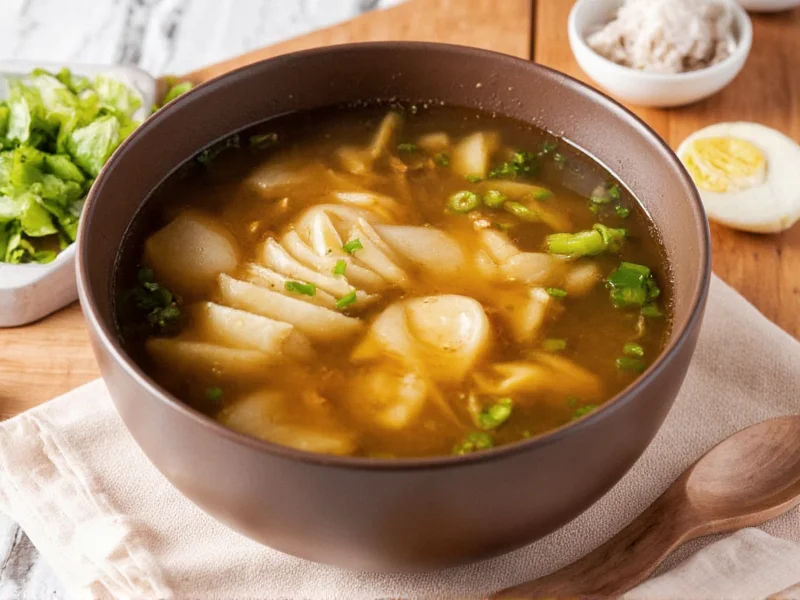Understanding the precise calorie content of miso soup is essential for those tracking nutritional intake or managing dietary goals. This Japanese staple offers a light yet flavorful option that fits well within various eating plans when prepared mindfully.
Factors That Influence Miso Soup Calorie Count
The calorie range for miso soup isn't fixed because multiple variables affect its nutritional profile. Let's examine what causes these variations:
| Ingredient Variation | Calorie Impact (per 8oz serving) | Typical Addition Amount |
|---|---|---|
| Basic miso paste only | 35-40 calories | 1-2 tablespoons |
| With silken tofu (¼ cup) | 45-55 calories | 2-3 oz |
| With wakame seaweed | 40-48 calories | 1 tablespoon dried |
| With scallions | 38-43 calories | 2 tablespoons chopped |
| Restaurant-style (heavier paste) | 50-70 calories | Varies by establishment |
Nutritional Composition Beyond Calories
While calorie count matters for dietary planning, miso soup offers valuable nutrients that contribute to its health profile. A standard serving typically contains:
- Protein: 2-3 grams from fermented soybeans in miso paste
- Sodium: 600-900mg (varies significantly by miso type and concentration)
- Carbohydrates: 4-6 grams, primarily from the miso fermentation process
- Healthy fats: Less than 1 gram in basic preparations
- Probiotics: Beneficial bacteria from the fermentation process
Serving Size Considerations for Calorie Tracking
When evaluating how many calories is in miso soup for your specific needs, serving size represents the most critical variable. Many restaurants serve miso soup in 10-12 ounce portions rather than the standard 8 ounces used in nutritional databases.
For accurate miso soup nutrition facts tracking:
- Measure your bowl size before adding soup
- Consider that restaurant servings often contain 25-50% more miso paste than home recipes
- Be aware that additional ingredients like mushrooms or extra tofu increase both volume and calories
Homemade vs. Commercial Miso Soup Calorie Comparison
Preparing miso soup at home gives you complete control over the calories in traditional miso soup. Commercial versions, whether from restaurants or instant packets, often contain higher calorie counts due to:
- Increased miso concentration for stronger flavor
- Added oils or flavor enhancers
- Larger serving sizes
- Additional high-calorie ingredients like egg or meat
An 8-ounce serving of homemade miso soup typically stays within the 35-50 calorie range when prepared with 1 tablespoon of miso paste, water or dashi broth, and minimal additions. The same serving from a restaurant might reach 60-75 calories due to richer preparation methods.
Creating Lower-Calorie Miso Soup Options
If you're monitoring your intake, several adjustments can reduce the calorie count by serving size without sacrificing flavor:
- Dilute miso paste with additional low-sodium dashi or water
- Use white miso (shiro miso) which generally contains fewer calories than red varieties
- Add volume with zero-calorie ingredients like mushrooms or spinach
- Avoid adding high-calorie extras like soft-boiled eggs or extra tofu
- Measure miso paste precisely rather than estimating
These modifications create low calorie miso soup options that maintain authentic flavor while fitting within stricter dietary requirements. A well-prepared light version can stay below 30 calories per 8-ounce serving.
Health Benefits Context for Calorie-Conscious Consumers
The nutritional value of miso soup extends beyond its modest calorie count. This fermented food offers several health advantages that make it valuable even for those focused on weight management:
- Probiotics support gut health and may improve metabolism
- Low energy density creates satiety with minimal calories
- High water content contributes to hydration
- Naturally low in fat while providing essential amino acids
- May help reduce appetite when consumed before meals
Research suggests that regularly consuming fermented foods like miso may support healthy digestion and potentially aid in weight management, making it a smart choice for those evaluating is miso soup good for weight loss.











 浙公网安备
33010002000092号
浙公网安备
33010002000092号 浙B2-20120091-4
浙B2-20120091-4